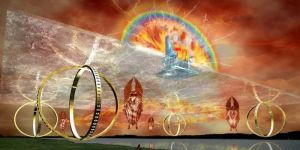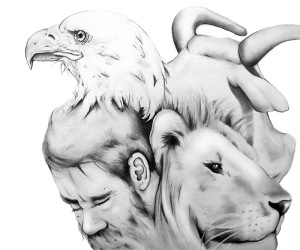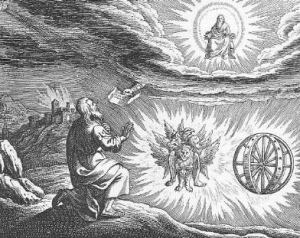Ezekiel’s vision of the Lord is not unlike the vision John has in Revelation 4. Both men see God on his throne, surrounded by heavenly attendants. Both men describe lightning, brilliant light, creatures unknown to man, and a brilliant rainbow in the midst of the heavenly vision.
We spent time in class reading Ezekiel’s throne theophany as contained in Ezekiel chapter 1 as well as John’s experience in Revelation 4. Accompanying the reading of the text I had images depicting what these prophets were seeing. To me, Ezekiel 1 and Revelation 4 were meant to be seen as much as read. To read the text without imagining what these seers saw is to miss the awesome nature of their vision. In the past I have also had students draw what they have read, it brings a degree of participation that can help draw students into what they are reading and take ownership of their learning experience.

Ezekiel’s description of “living creatures… lifted up from the earth… (with) wheels… lifted up” (Ezekiel 1:19) is similar to John’s description of a “sea of glass like unto crystal: and in the midst of the throne, and round about the throne, were four beasts full of eyes before and behind. And the first beast was like a lion, and the second beast like a calf, and the third beast had a face as a man, and the fourth beast was like a flying eagle…” (Revelation 4:6-7)

From Joseph Smith we learn that the beasts are literal creatures but that they also describe “heaven, the paradise of God, the happiness of man… (and) represent the glory of the classes of beings in their destined order or sphere of creation, in the enjoyment of their eternal felicity” (D&C 77:2-3). Ezekiel lists the similar creatures in Ezekiel 1:10. These four creatures find a similar counterpart in the lower portion of facsimile 2 as well. The number of them could also be significant as their were two cherubim sewn into the veil of the temple as well as two cherubim on the mercy seat on the ark of the covenant. This could represent the guardians of the throne of God.
Richard Draper stated:
Besides praising God, these living creatures may have another important function. In other apocalyptic literature such creatures, called cherubim, act as guardians of the throne of God and at times as guides. Cherubs are always associated with God but more especially in two capacities: as his steeds or chariots, as in Ezekiel 1, and as guardian figures keeping safe the way of God, as here in Revelation. They seem to work with the Seer particularly in the capacity as guides. At specific points they open up portions of the vision for him to view (Richard Draper, Opening the Seven Seals: The Visions of John the Revelator, Deseret Book, 1991, p.49).
Eat the book
 In Ezekiel 2 and 3 we read that the Lord gives Ezekiel a book and commands him to eat the book. This has a high degree of agreement with the experience of John the Revelator as well as told in Revelation 10. Ezekiel describes the book as tasting like “honey for sweetness”(Ezekiel 3:3), but when he reads the book he sees “lamentations, mourning, and woe” (Ezekiel 2:10). John sees an angel who gives him a book. “Give me the little book. And he said unto me, Take it, and eat it up; and it shall make thy belly bitter, but it shall be in thy mouth sweet as honey. And I took the little book out of the angel’s hand, and ate it up; and it was in my mouth sweet as honey: and as soon as I had eaten it, my belly was bitter” (Revelation 10:9-10). This scroll contains John’s mission, which is to “gather the tribes of Israel” (D&C 77:14). I asked the class, “how is a prophet’s mission both sweet and bitter?” We had a discussion on the role of prophets and the burdens they must carry.
In Ezekiel 2 and 3 we read that the Lord gives Ezekiel a book and commands him to eat the book. This has a high degree of agreement with the experience of John the Revelator as well as told in Revelation 10. Ezekiel describes the book as tasting like “honey for sweetness”(Ezekiel 3:3), but when he reads the book he sees “lamentations, mourning, and woe” (Ezekiel 2:10). John sees an angel who gives him a book. “Give me the little book. And he said unto me, Take it, and eat it up; and it shall make thy belly bitter, but it shall be in thy mouth sweet as honey. And I took the little book out of the angel’s hand, and ate it up; and it was in my mouth sweet as honey: and as soon as I had eaten it, my belly was bitter” (Revelation 10:9-10). This scroll contains John’s mission, which is to “gather the tribes of Israel” (D&C 77:14). I asked the class, “how is a prophet’s mission both sweet and bitter?” We had a discussion on the role of prophets and the burdens they must carry.
At this point my students have seen something most have not seen before. For most of them, they have never heard of prophets seeing the things described by Ezekiel and John. They have not heard of prophets “eating” books before. It is at this time I take them to familiar territory: the Book of Mormon.
In 1st Nephi chapter 1 we read the same story as told by Ezekiel and John. In this chapter Lehi has a throne theophany. He states:
Wherefore it came to pass that my father, Lehi, as he went forth prayed unto the Lord, yea, even with all his heart, in behalf of his people. And it came to pass as he prayed unto the Lord, there came a pillar of fire and dwelt upon a rock before him; and he saw and heard much; and because of the things which he saw and heard he did quake and tremble exceedingly. And it came to pass that he returned to his own house at Jerusalem; and he cast himself upon his bed, being overcome with the Spirit and the things which he had seen. And being thus overcome with the Spirit, he was carried away in a vision, even that he saw the heavens open, and he thought he saw God sitting upon his throne, surrounded with numberless concourses of angels in the attitude of singing and praising their God. And it came to pass that he saw One descending out of the midst of heaven, and he beheld that his luster was above that of the sun at noon-day. And he also saw twelve others following him, and their brightness did exceed that of the stars in the firmament. And they came down and went forth upon the face of the earth; and the first came and stood before my father, and gave unto him a book, and bade him that he should read. And it came to pass that as he read, he was filled with the Spirit of the Lord. And he read, saying: Wo, wo, unto Jerusalem, for I have seen thine abominations! Yea, and many things did my father read concerning Jerusalem—that it should be destroyed, and the inhabitants thereof; many should perish by the sword, and many should be carried away captive into Babylon. And it came to pass that when my father had read and seen many great and marvelous things, he did exclaim many things unto the Lord; such as: Great and marvelous are thy works, O Lord God Almighty! Thy throne is high in the heavens, and thy power, and goodness, and mercy are over all the inhabitants of the earth; and, because thou art merciful, thou wilt not suffer those who come unto thee that they shall perish! And after this manner was the language of my father in the praising of his God; for his soul did rejoice, and his whole heart was filled, because of the things which he had seen, yea, which the Lord had shown unto him (1 Nephi 1:5-15).
Here we have a prophet having a vision of God on his throne, surrounded with attendants, with One descending that is brighter than the sun. Twelve others brighter than stars come down as well to converse with the prophet Lehi. He is given a book, and is filled. Though the text does not mention him eating the book, the imagery of being filled with the Spirit while at the same time filled with woe exists. The book is sweet- he is filled with the sweet Spirit of God, yet the message is one of doom- Jerusalem is filled with wickedness. Also contained in the midst of this message is hope for those who “come unto” the Savior of the world (1 Nephi 1:14).
Ezekiel, John and Lehi’s Visions: A Practical Application
In every instance, the reaction of these individuals having these experiences is one of obedience. They “eat their mission up” so to speak. This is a great message for the youth of the Church in the Latter-days. Yes we are surrounded with forces of darkness. Yes we do have reasons to want to slaken our pace; but by “eating the book” we not only find that there is sweetness to the work, but we also find the power and strength to withstand the bitterness. Whether we want to face it or not, this world has its share of bitterness. Choosing to the live life without the gospel will not make the bitterness go away, but we will lose the Spirit if we leave the strait and narrow path. Asking questions to this end will bring about a great discussion in the classroom. “When have you felt the sweetness of your calling? What happened? How did your serving the Lord change you personally?”
While some of these questions can be advanced for some seminary students depending on age and experience, many youth have experience in tasting the sweetness of the gospel in their lives. We also explored ways in which youth do things “half way” versus “going all out” or “eating” their assignment. The application to the young people is highly personal here. It was not my goal to explain to them how to “eat the book”, only that they can find personal application as they explore how Ezekiel, John, and Lehi reach out to them through their message.

I was reading Ezekiel 1 today and after praying -found it to parallel the pioneers going across the plains. The book being the book of mormon. The wagon ascending being those who died on the plains. the wagon on its side -when the wagons circled at night. The wagons going in a straight path not turning left or right. The pioneers being filled with the spirit. They are like all the creatures mentioned. There are some in front where they are going and some behind where they came from. I definitely saw it through new eyes.- knowing Ezekiel is prophecy for the latter- days, I wanted to understand. the whirlwind and fire like them leaving the Nauvoo temple – calf’s foot – they plotted along at the speed of the oxen. The wings like leaving and yet united in flight. wings stretched upward as to put their faith in heaven to where they were going. They had the spirit of God with them- a fire was bright. dreadful- obvious of the hard times the pioneers had. And when the wheels were lifted up- or those who went to heaven, Those eyes round about them as the angels watching and lifting the wheels etc. You can read and make your own parallels. I just wanted to share.
I could be wrong, but I think Ezekial 1 is describing a modern day airplane.. The wheel within a wheel are the tires and the rims. He describes take-off in vs 14, 17, 24 and how a plane does does not turn but goes straight out when it takes off. And when they park the plane the wings slightly drop down in vs 24. And when it is parked, the back legs/wheels bend slightly in-ward and the two front wheels stand together out in front (like the stance of a baby calf with the hind legs spread apart and slightly bent, and the front hooves together) vs 7. After take-off the wheels are taken up inside the plane in vs 19, 20, 21. And the wings bend slightly upward as it flies, vs 11. The “Throne” is the cock pit with lights all around and a man sitting in it vs 26. The rings are the windows and they are full of eye (passengers) vs 18.
Thanks for your input!
So powerful and edifiying.God bless you and reveal Himself to you in every way.
Thanks, Most Importantly For The Images,Its Give A Clear & vivide Understanding Of What ( EZEKIEL ) Saw.
Thanks for visiting!